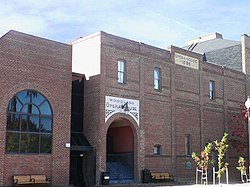
Woodland is a city in, and the county seat of, Yolo County, California, United States. It is located approximately 15 miles (24 km) northwest of Sacramento, and is a part of the Sacramento metropolitan area. The population continues to grow every year, with a growth rate of 0.33% annually, and a current population of 61,873.

The Tennessee Theatre is a movie palace in downtown Knoxville, Tennessee. The theater was built in 1928 in the 1908 Burwell Building, considered Knoxville's first skyscraper. The theater and Burwell Building were added to the National Register of Historic Places in 1982, and the theater was extensively restored in the early 2000s. The Tennessee Theatre currently focuses on hosting performing arts events and classic films, and is home to the Knoxville Opera and the Knoxville Symphony Orchestra. The theater is managed by AC Entertainment.

William Henry Weeks (1864–1936) was an early 20th-century architect who designed hundreds of buildings including many schools, banks, and libraries. He was best known for the monumental neoclassical style of his public buildings, although he had employed other architectural styles earlier in his career. His first office was in Watsonville, California, but later offices were in various parts of the San Francisco Bay area. Weeks' firm designed structures in over 161 California cities, as well as several buildings in Nevada and Oregon. Weeks was a pioneer in earthquake-resistant construction and, as a result, many of his buildings are still in use.

Monterey State Historic Park is a historic state park in Monterey, California. It includes part or all of the Monterey Old Town Historic District, a historic district that includes 17 contributing buildings and was declared a National Historic Landmark in 1970. The grounds include California's first theatre, and the Monterey Custom House, where the American flag was first raised over California.

The Chicago Theatre, originally known as the Balaban and Katz Chicago Theatre, is a landmark theater located on North State Street in the Loop area of Chicago, Illinois. Built in 1921, the Chicago Theatre was the flagship for the Balaban and Katz (B&K) group of theaters run by A. J. Balaban, his brother Barney Balaban and partner Sam Katz. Along with the other B&K theaters, from 1925 to 1945 the Chicago Theatre was a dominant movie theater enterprise. Currently, Madison Square Garden, Inc. owns and operates the Chicago Theatre as a 3600 seat performing arts venue for stage plays, magic shows, comedy, speeches, sporting events and popular music concerts.

The Newberry Opera House, located in Newberry, South Carolina, is a fully restored historic building that is a live-performance space for popular artists, touring theatre companies, and local organizations. It is listed on the National Register of Historic Places in 1969.
Zamora is an unincorporated community in rural Yolo County, California, U.S., on Interstate 5 due west of Knights Landing. Its ZIP code is 95698 and its area code 530. It is in the northern part of the county. "Zamora District is bordered by County Road 10 to the north and County Road 16 to the south, County Road 85 on the west and Highway 113 on the east. In 1879, Zamora District included the areas of West Grafton, the eastern portion of Fairview, and a small strip of East Grafton. The Zamora District encompasses Oat Valley, along Oat Creek in the northwestern part of the district and Hungry Hollow which is in an area along the foothills west of Zamora."

Architectural Resources Group is a firm founded in 1980 by Bruce Judd and Steve Farneth in San Francisco, California. It began by providing professional services in the fields of architecture and urban planning with particular expertise in historic preservation. In 2000, David Wessel, a Principal of ARG, founded a separate conservation-contracting division, ARG Conservation Services which operates under the same roof as ARG. By 2005, the firm had expanded to a full-service architecture firm with 50+ employees. ARG also opened offices in Pasadena serving Southern California, and Portland, Oregon, serving the Pacific Northwest.

The Riley Center, also known as the Grand Opera House and formally as the Mississippi State University Riley Center for Education and Performing Arts, is a performing arts and conference center in Meridian, Mississippi. It was added to the National Register of Historic Places in 1972.

The Ramsdell Theatre is a historic playhouse theater building and opera house at 101 Maple Street in downtown Manistee, Michigan. The building was financed by local businessman and politician Thomas Jefferson Ramsdell and was built in 1902. It replaced the town's two previous opera houses which had been destroyed by fire, one in 1882 and the other in 1900. Besides producing plays the facility was later used as a movie theater. James Earl Jones started his acting career at the theater as an actor and stage manager.
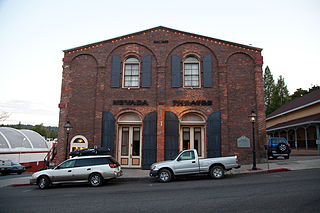
The Nevada Theatre, also known as the Cedar Theatre, located in downtown Nevada City, California, is California's oldest existing theater building. Its principal periods of significance were 1850–1874, 1875–1899, 1900–1924, and 1925–1949. It is situated on ancestral Nisenan land.
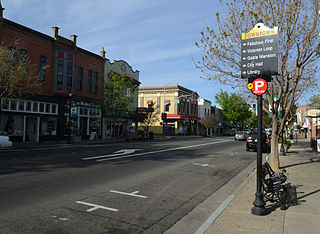
The Downtown Woodland Historic District is a historic district in Woodland, California. The district encompasses roughly 370 acres (1.5 km2) and 59 contributing buildings. It is a California Historical Landmark and is listed as a historic district on the National Register of Historic Places.

The Woodland Public Library is the oldest, and one of the last functioning Carnegie-funded libraries in California. It is on the National Register of Historic Places and is a contributing property of the Downtown Woodland Historic District.

The Gable Mansion is a Victorian mansion in Woodland, California, listed as a California Historical Landmark, that was built in 1885 for Amos and Harvey Gable, two Yolo County pioneers and ranchers.
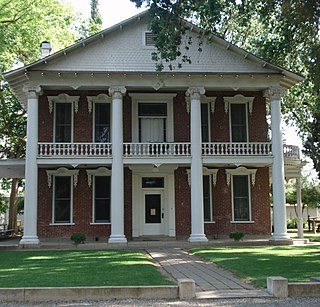
The Gibson House is a historic house that now serves as a museum in Woodland, California. It exemplifies several architectural styles, including Georgian Revival, Italianate and Neoclassical. It was listed in the National Register of Historic Places in 1976.

The Yolo County Courthouse was a courthouse for the Superior Court of California in Yolo County in Woodland, California until 2015. The original building was erected in 1864, and was used for 37 years until condemned in 1911. The edifice, built in the same location in 1917, was listed on the National Register of Historic Places in 1987, and is also a contributing property in the Downtown Woodland Historic District.
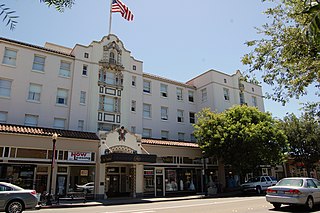
Hotel Woodland is a historic hotel located in Woodland, California and designed by William Henry Weeks. The hotel is on the National Register of Historic Places, and is a contributing property of the Downtown Woodland Historic District.

The Porter Building is a historic building listed on the National Register of Historic Places located in the Downtown Historic District of Woodland, California.
The performing arts in Detroit include orchestra, live music, and theater, with more than a dozen performing arts venues. The stages and old time film palaces are generally located along Woodward Avenue, the city's central thoroughfare, in the Downtown, Midtown, and New Center areas. Some additional venues are located in neighborhood areas of the city. Many of the city's significant historic theaters have been revitalized.
